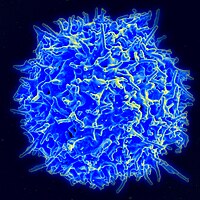
Photo from wikipedia
CD8+ tissue-resident memory T (TRM) cells play crucial roles in defense against infections and cancer and have been implicated in autoimmune diseases such as psoriasis. In mice and humans, they… Click to show full abstract
CD8+ tissue-resident memory T (TRM) cells play crucial roles in defense against infections and cancer and have been implicated in autoimmune diseases such as psoriasis. In mice and humans, they exist in all nonlymphoid organs and share key characteristics across all tissues, including downregulation of tissue egress and lymph node homing pathways. However, recent studies demonstrate considerable heterogeneity across TRM cells lodged in different tissues - linked to the activity of tissue-specific molecules, including chemokines, cytokines, and transcription factors. Current work indicates that transforming growth factor (TGF)-β plays a major role in generating TRM heterogeneity at phenotypic and functional levels. Here, we review common and unique features of TRM cells in different tissues and discuss putative strategies aimed at harnessing TRM cells for site-specific protection against infectious and malignant diseases.
Journal Title: Trends in immunology
Year Published: 2021
Link to full text (if available)
Share on Social Media: Sign Up to like & get
recommendations!